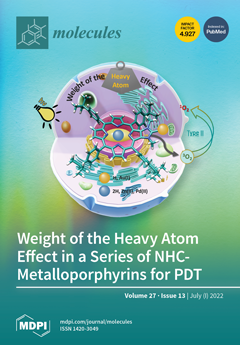1,3,6,8-Tetrasubstituted pyrene derivatives with two types of substituents (4-(2,2-dimethylpropyloxy)pyridine, 1-decyl-1,2,3-triazole, 1-benzyl-1,2,3-triazole, and pyrazole), substituted in such a way that provides the long axial symmetry, are prepared and characterized in the present study. To the best of our knowledge, the pyrene derivative containing the
[...] Read more.
1,3,6,8-Tetrasubstituted pyrene derivatives with two types of substituents (4-(2,2-dimethylpropyloxy)pyridine, 1-decyl-1,2,3-triazole, 1-benzyl-1,2,3-triazole, and pyrazole), substituted in such a way that provides the long axial symmetry, are prepared and characterized in the present study. To the best of our knowledge, the pyrene derivative containing the same heteroaryl motif (triazole) but substituted by two various alkyls, straight decyl and benzyl-based side chains (
C), is reported for the first time. For comparison, compounds with one kind of triazole motif and substituted pyridine or pyrazole groups were prepared (
A and
B). The photophysical properties of all molecules were evaluated by thermogravimetric analysis (TGA) and UV-Vis spectroscopy (absorption and emission spectra, quantum yields, and fluorescence lifetimes). The obtained results were compared to analogues substituted at the 1,3,6,8 positions by one kind of substituent and also with all the 1,3,6,8-tetrasubstituted pyrenes reported in the literature substituted by two kinds of substituents with a substitution pattern that provides long axial symmetry. In addition, theoretical studies based on DFT and TD-DFT were performed that supported the interpretation of the experimental results. The photophysical properties of tetrasubstituted pyrene derivatives having triazole units at the 1,8-positions, respectively, and other identical substituents at the 3,6 positions show the dominance of triazole units in the pyrene framework; the dominance is even higher in the case of the substitution of 1,3,6,8 positions by triazoles, but containing two various alkyls.
Full article






